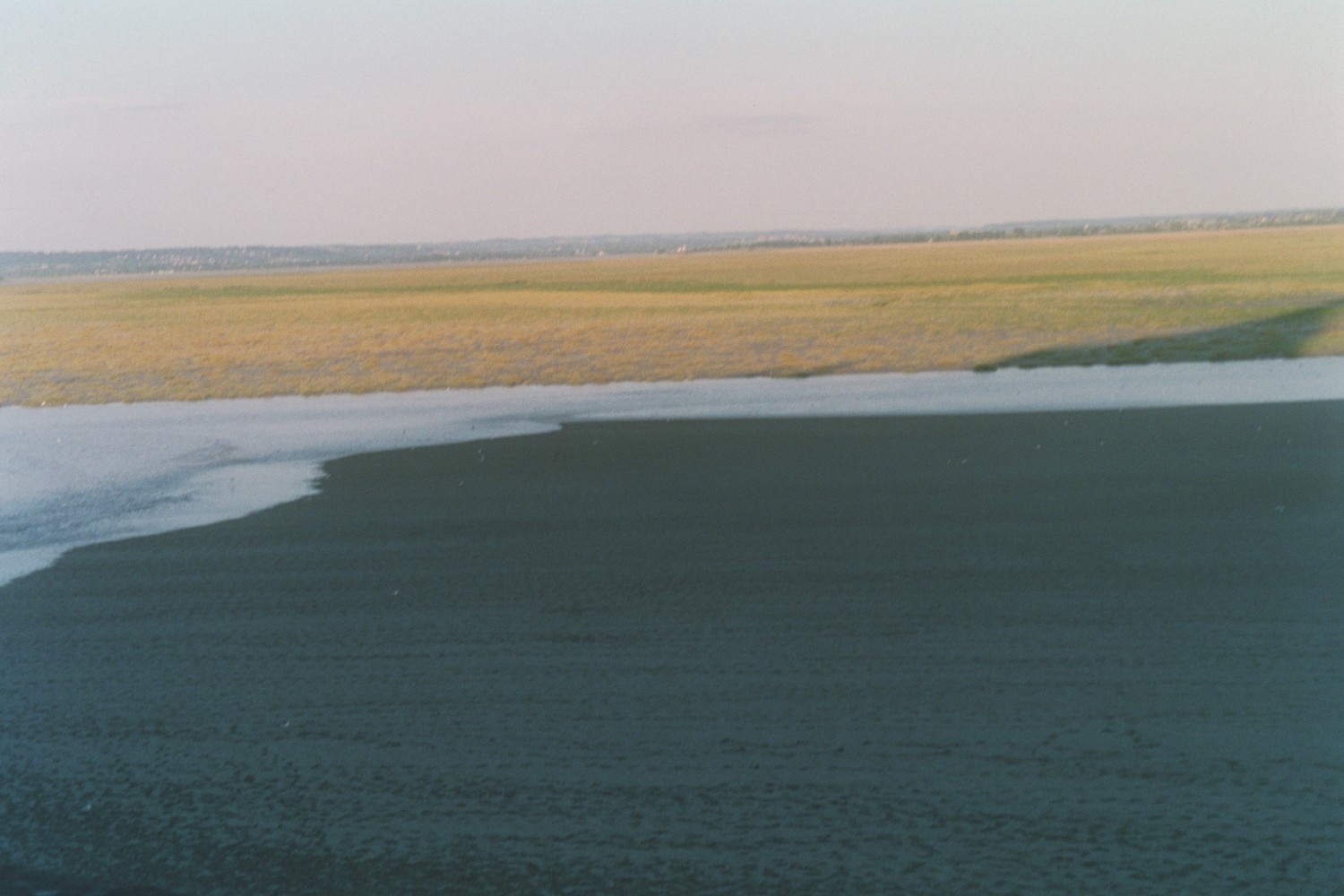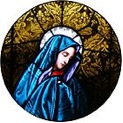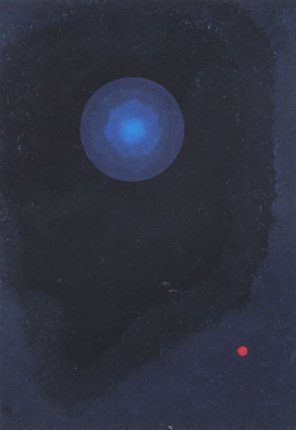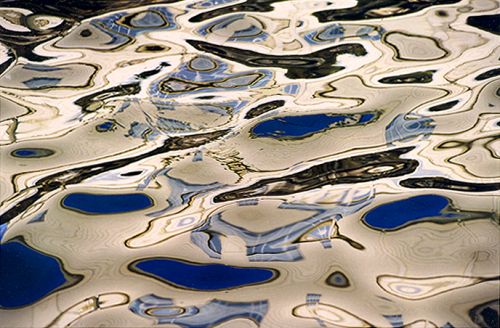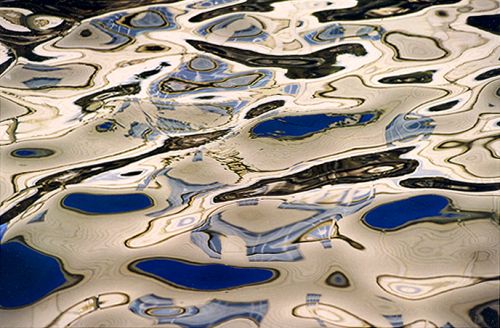Introduction: the many shades and meanings of Blue
The color blue intrigues. On the landscape of both the outer world and the inner one, blue holds a central place. If asked to name a favorite color, most adults around the world, cutting across lines of culture and gender — will say it is blue. Blue has an obvious presence, both in our external world and on our interior ‘mindscape’. Interestingly, ‘blue’ has also come to have an iconic place on the inner landscape of the synesthete, as we will see in this essay.
In the outer world, blue is all around us: in the sky, the sea, it is the central color of the natural world. On our ‘inner landscapes’, blue skies and seas have all the symbolic meanings we have come to ascribe to them: the source of Life, and Life in all its diversity, depth and aspirations.
View from Mont-St-Michel by P.L. Duffy
It is this range of blue shades within the constancy of the color that led author William Gass to designate blue as “the most suitable color” to represent the spectrum of moods and feelings on our inner landscapes. As Gass writes in his essay, On Being Blue:
Of the colors, blue and green have the greatest emotional range. Sad reds and melancholy yellows are difficult to turn up….Although green enlivens the earth and mixes in the ocean and we find it, copperish in fire, green air, green skies, are rare. Gray and brown are widely distributed… there are no joyful swatches of either, or of any exuberant black, sullen pink, or acquiescent orange. Blue is therefore the most suitable color of interior life. (p. 73)
Blue has so many different shades, evokes so many different moods and yet still remain blue.
Blue is a dependable constant in the natural world, but it has varied faces. Because of its many shades, ‘blue’ can keep us transfixed, watching the sea and the sky from coveted balconies, windows and shores.
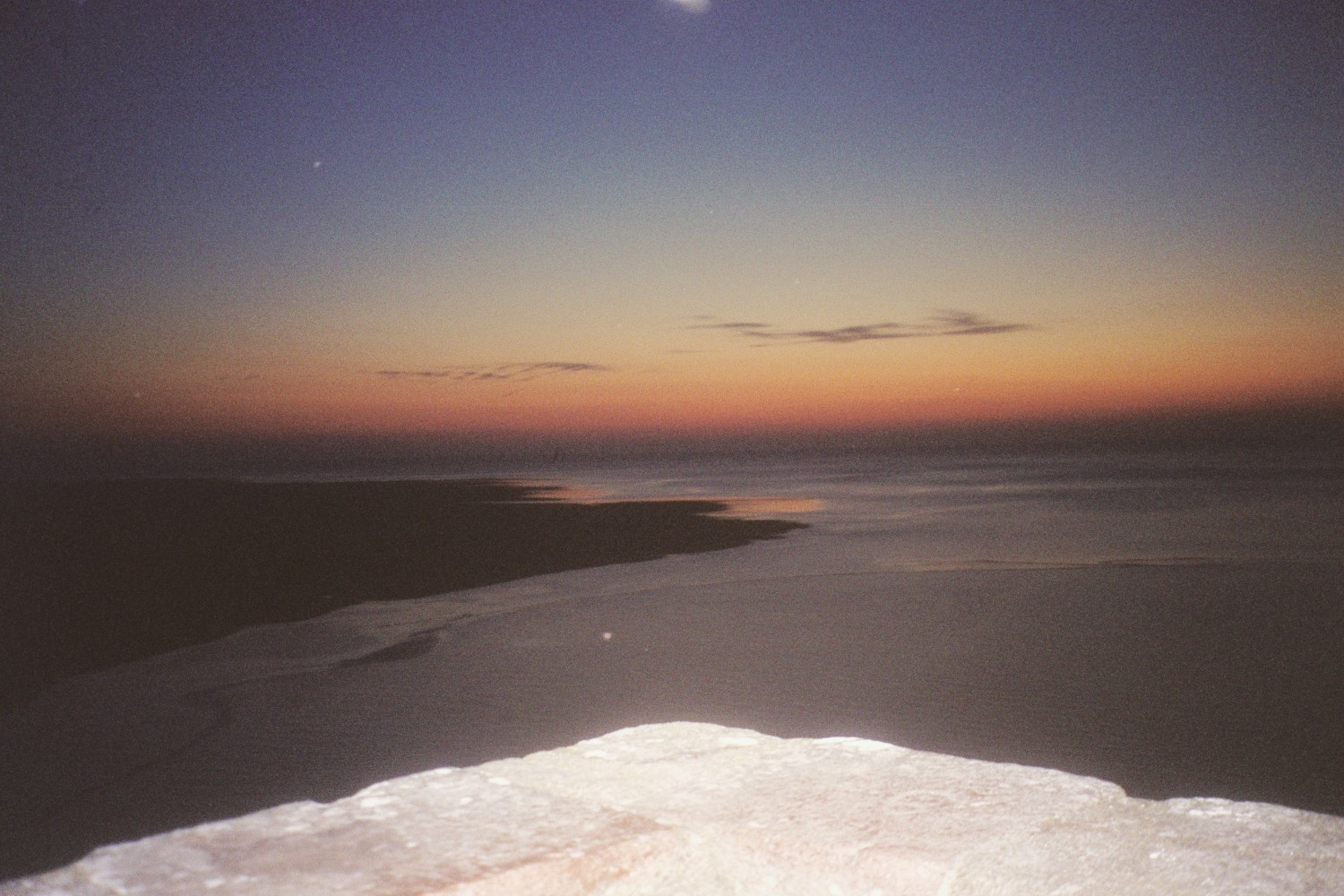
View from Mont St-Michel, twilight by P.L. Duffy
Like ourselves and our many levels of awareness, blue is varied and is yet the same. This is not true of all colors. Others give up their character radically when attempts are made to lighten or darken them. As the artist Raoul Dufy said,
“Blue is the only color which maintains its own character in all its tones…it will always stay blue; whereas yellow is blackened in its shades, and fades away when lightened; red when darkened becomes brown, and diluted with white is no longer red, but another color – pink.”
The great range of blue shades are everywhere in the outer world, along with the symbolic meanings they carry in our inner worlds. Among the states, blue can signify are happiness (“it’s all blue skies and clear sailing”), sadness (in music, “the blues”), depth (“love as deep as the ocean”), heights (celestial realms”), even the erotic (in English, “blue movies” and “blue novels” are erotic ones), and solitude (going to a ‘blue room’ can represent being in a dimension apart).
Blue as iconic color of the experience of synesthesia
“Being in a dimension apart’ may describe the experience of the synesthete, who has perceptions which most do not share. Additionally, with its versatile and evocative nature, ‘blue’ can be an” iconic color” for synesthetes: some recent literary references to blue have this single color portraying the spectrum of colors on the synesthete’s inner landscape. If one wants one color that can evoke a sense of range and variety, ‘blue’ would seem like the right fit.
It is striking that, in the last decade, six of the most known contemporary English-language books on synesthesia (both fiction and non-fiction) have ‘blue’, in their titles: Blue Cats and chartreuse Kittens (2001); The Sound of Blue by Holly Payne (2005); Born on a Blue Day by Daniel Tammet (2006); The Frog who Croaked Blue by Jamie Ward (2008); Wednesday is Indigo Blue (2009); Amaryllis in Blueberry by Christina Meldrum (2011).
In each case, authors describe a synesthetic experience that evoked the color blue for them. In the case of the book, Blue Cats the word, ‘cat’ evokes blue; for the composer-character in The Sound of Blue, a moving musical composition evokes blue; for author Daniel Tammet, the day, Thursday evokes blue; similarly, in Wednesdays are Indigo Blue, authors Eagleman and Cytowic describe a synesthete for whom the day Wednesday evokes a particular shade blue; author describes a synesthete for whom the sound of a frog’s croak evokes blue; for a character in Meldrum’s novel, color accompanies paranormal experience.
It is curious that all these diverse authors chose ‘blue’ to represent the experience of synesthesia when in truth, the synesthetic response evokes a great range of colors for those who are hosts to synesthesia; so why in each in each of the above cases, did the authors choose to represent their multi-color synesthetic perceptions with an experience of blue?
Blue, its history and evolution of meanings
It may be helpful here to examine the history of the color blue and how it began to take on its spectrum of meanings: from the heavens, to imagination, to solitude, to the erotic, to the private, to the idiosyncratic.
Interestingly, it is only when humans first learned to reproduce the color blue widely, that it began to take on an array of symbolic meanings.
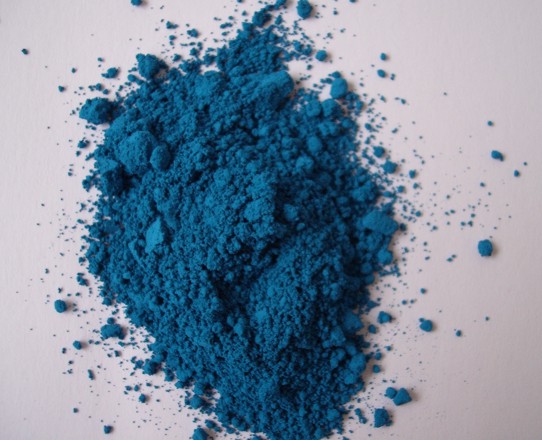
Human beings had wide access to blue dye relatively late in their history. While the first dyeing techniques (for red and yellow) were developed even before the Neolithic period, those for blue were few and far between, confined to areas with access to indigo and woad. Moreover, the process of extracting blue for dye from the latter was laborious and difficult.
Later, the greater facility in reproducing the color blue widely gave human beings a measure of power to transform their outer environment, putting it in line with the symbolic associations of their inner worlds. Much later (in the modern period), the color blue itself came to be identified with the transformative power of human imagination, as we shall see later in this essay.
One of the first broad applications of the newly developed capacity to create blue—was to bring a bit of heavenly glory to the earth. Beginning in the twelfth century, the use of blue stained glass in church windows represented the shimmering power of the heavens. This first use of blue in stained glass was at the Cathedral of Saint-Denis, then later at the cathedral at Chartres. After that, its use spread to many other cathedrals and churches throughout Europe.
As the painter, Kandinsky said, “Blue is the typical heavenly color”. (p. 38)
Because of its identification with the Heavens, ‘blue’ came to represent ‘spirit’. One thinks of religious figures from diverse traditions portrayed in blue: the blue robes of the Virgin Mary; the blue skin of Lord Vishnu; the Blue Lotus Buddha:
A number of artists such as contemporary poet Claudine Helft have identified blue with heaven and the absolute as in her work, “L’infinitif du bleu”:
La souffrance n’est qu’une pluie
Goutée sur l’infinitif des mers:
L’annonce est un éveil
où la blancheur moléculaire
renverse l’ordre d’un temps trop bleu
où la pesanteur se fait vitesse
et la défaite de l’absolu,
le revers du ciel. (p. 51)
Blue can represent a fusion of outer and inner landscapes, as does the experience of synesthesia.
Blue connoting singularity, solitude and shelter
Blue may be the most appropriate color to represent the singular nature of the experience of synesthesia. As synesthetic experience cannot be fully shared, synesthetes can feel alone with their perceptions. Blue can represent a sense of isolation, as Gass writes: “To be in the blue is to be isolate and alone. To be sent to the blue room is to be sent to solitary, a chamber of confinement.” (p. 18)
Yet sharing solitary experience through art allows the synesthete-artist to feel heartened and connected. All art is an attempt to bring the inner world to the outer, but perhaps this may be particularly striking in the case of synesthete-artists.—whose color perceptions of music, word, or sound go beyond the metaphoric to the literal.
In the novel, The Sound of Blue, the main character, Milan is a synesthete- composer who experiences a color dimension to music: the color blue particularly moves and inspires him with the depth it suggests. As Milan says, “Blue is the opening and closing door to all that matters and gives my life meaning” (p. 91). The composer also experiences ‘Blue’ as an environment that is a private refuge: “He felt secure in the music and sheltered… within the shades and shadows of blue.” (p. 91) In the novel, the composer shares the beauties of blue with others through the music he composes.
Blue connoting imagination and putting the human stamp on nature
With its range of possible evocations, blue has inspired a number of artists. Modern artists, particularly, have used the color to give form to the invisible inner worlds of their subjects.
Consider the ‘Blue Period’ of Picasso with paintings such as the 1903 work, The Old Guitarist. The blue color has little to do with the literal colors of the guitarist’s face, hair, and hands, but everything to do with his feeling of depth, sadness, and devotion to the music he plays.
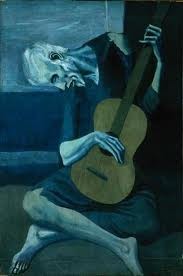
Picasso’s “Old Guitarist” in turn inspired the American poet, Wallace Stevens’ 1937 poem “The Man with the Blue Guitar”. As Stevens wrote,
“Things as they are
Are changed upon the blue guitar.” (p. 165)
Here the blue of the blue guitar represents the vast power of imagination to transform nature or “things as they are”.
The poet Stevens believed that imagination was god-like as it was what gave human beings the potential to put their own human stamp on the world. In Stevens’ post World War I era when many questioned the conventional tenets of traditional religious belief, Stevens saw the works of the imagination as providing an alternative system of values. As Stevens wrote, “After one has abandoned a belief in God, poetry is that essence which takes its place as life’s redemption… (Opus Posthumous, p.185). In his poem, “Final Soliloquy of the Interior Paramour”, Stevens writes: ”We say God and the imagination are one.” (Collected Poems, p.526). The imagination became synonymous with Heaven; both were identified with blue.
Similarly, during the early twentieth century Blue Rider movement in art, artists sought to bring inner human experience to the outer landscape. Blue held a central place in the movement as artists applied the color where Nature never had, as in this 1911 painting, The Blue Horse by Franz Marc.
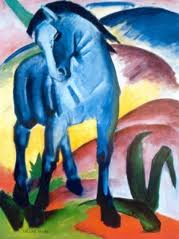
The color ‘blue’ evokes the primacy of the human imagination in putting its stamp on the natural world. To color a horse blue can be seen as capricious, but it is the right of the imagination to be so and to assert personal or collective symbology, here through color. In the case of Marc’s Blue Horse the color blue brings out the inner nobility, even spirituality of the painting’s subject.
The color blue connoting depth
In his work, The Spiritual in Art, Kandinsky wrote:
“The power of profound meaning is found in blue…The inclination of blue to depth is so strong that its inner appeal is stronger when its shade is deeper.” (p. 38).
http://www.wassilykandinsky.net/work-217.php
In bringing inner vision to the outer reality, the many shades of blue allowed artists to simulate a three-dimensional quality to their artistic creations. The range of blue shades permitted British painter David Hockney to create his all-blue stage set for the opera Rossignol, and to bring a sense of three-dimensionality to his uni-color stage set: the layered blue shades created the illusion of depth.
The color blue connoting the capriciousness – yet seriousness–of synesthetic perception
Interestingly, Hockney, a music-color synesthete, reports perceiving a visual blue-colored dimension to the music of Rossignol. As Hockney of the opera, “The first thing you notice is that it’s all blue—but infinite shades of blue” (Blue Cats.p.116). In his stage set, Hockney created a magical world of blues showing a dimension far from our familiar “everyday” world, or state of consciousness.
Some say the American painter Georgia O’Keefe was a synesthete. Mostly noted for her painting of huge flowers and desert landscapes, O’Keefe was also an artist of the “inner territory”. In a book about her life, O’Keefe writes that, in an artistic experiment, she limited herself to charcoal until she found she really needed a color to express what she wanted to express. Six months into the experiment, she wrote that she could not do without blue. She used it for a work called Blue Lines, later for a 1921 painting called Blue and Green Music, the study below called Blue Green:
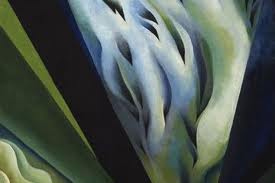
In her painting, Red Commas on Blue, the contemporary artist and synesthete Carol Steen has created a dimension of blue that seems personal, yet at the same time cosmic. The artist explains her synesthetic response that evoked the blue color with the arcs of red:
“There was a song I heard years ago with such an electronically altered voice that it made me want to paint it. I had never heard a voice sound or look like that before, it was such a beautiful blue, and it was the same color blue as salt tastes to me. The red arcs were the drums”
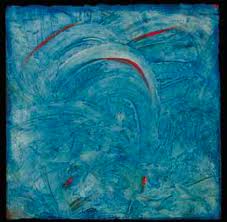
“Red Commas on Blue” by Carol Steen, 2004, 18 cm x 18 cm
Carol Steen has spoken elegantly on her experience of synesthesia, describing it as “extra consciousness”. In an interview, she said, “The point of synesthesia is not, ‘Oh, you have this weird thing. The point is you have this extra consciousness and you use it.” (p. 55, Blue Cats)
“Red Commas on Blue” shows an intensely personal dimension that yet evokes expanded consciousness with its swirling blue intensified by streaks of earthly red.
In Daliland, synesthete photographer Marcia Smilack creates a shimmering, reflective world of blue that brings the sky into the ocean:
“Daliland” by Marcia Smilack, 1999, 40 cm x 60 cm
Smilack has said that she would describe the experience of synesthesia as “dreaming while awake”. Of the image, Daliland, she says:
I took this picture on a late July afternoon when the sky is often cobalt blue. In reflection, the blue surrounded the edges of a white building though the building was of no importance compared to the intensity of the cobalt sky. Then a boat took off a few hundred yards away, sending a wave that rose up in the center of the reflection and transformed everything into new shapes; I remember feeling that someone had poured a pot of white paint on top of the sky momentarily covering it completely; but a second later, the blue rose up and reconstituted itself inside circles and shapes that reminded me of the melting clocks of Dali’s painting of time while the white shingles of the building became a background to the blue that hardly looks wet at all.
Smilack refers to the centrality of blue, rising up amid the diversity of shapes, asserting itself. The synesthesia of Smilack, (who for many years lived on Martha’s Vineyard, an island off the coast of Massachusetts) is often elicited by the play of light on the surface of the ocean. The shimmering light evokes synesthetic sensations for her—which also alert her as to when to press the shutter camera—to get the striking ‘reflectionist’ effects shown in her work.
Interestingly, certain of William Gass’ cross-sensory descriptions of blue make one wonder if the author, himself was a synesthete: “Nothing stands in the way of blue’s being smelled or felt, eaten as well as heard” (p. 76) and “One thing is certain: a cool flute blue tastes like deep well water drunk from a cup” (p. 77).
The color blue as bridge between inner and outer landscapes
The blues of the sky and the blue of the ocean go through a kind of alchemy in the human brain— to spin a range of possible meanings, both collective and personal –which are in turn projected back onto the outer world we share.
Perhaps there is no better way to sum up the great array of blues and all they suggest than with this final quote from William Gass in On Being Blue:
“Whether slick light sharp high bright thin quick sour new and cool or low deep sweet thick dark soft slow smooth heavy old and warm: blue moves easily among them all, and all profoundly qualify our states of feeling.” (p. 76).
Bibliography
Cytowic, Richard, The Man who Tasted Shapes. New York: Putnam. 1993
Duffy, Patricia Lynne. Blue Cats and Chartreuse Kittens: How synesthetes color their worlds. New York: Henry Holt & Company. 2001. p.55, p. 116.
Gass, William, On Being Blue: A Philosophical Inquiry. Jaffrey, New Hampshire: David Godine Publishers. 1999. (Originally published 1976). pp. 73-76.
Greenough, Sarah, My Faraway One: Selected Letters of Georgia O’Keefe and Alfred Steiglitz 1915-1933. New Haven: Yale University Press, 2011.
Harrison, John, Synaesthesia: The Strangest Thing. Oxford: University Press. 2001.
Helft, Claudine, L’Infinitif du bleu L’Age D’Homme, Lausanne 1992. p. 51
Kandinsky, Concerning the Spiritual in Art. New York: Dover Publications. 1977. (Originally published 1914). p. 37—38.
O’Keefe, Georgia, (edited by Bryer, Doris) Some Memories of Drawings. Atlantis Editions: 1988.
Pastoureau, Michel. Blue: History of a Color. Princeton: Princeton University Press.2001 (Originally published in French, Editions de Seuil. 2000).
Payne, Holly, The Sound of Blue. New York: Plume, Penguin Group. 2005. pp. 90-91.
Stevens, Wallace, The Collected Poems of Wallace Stevens. New York: Vintage. 1990. (Originally published 1954). p. 165.
Stevens, Wallace. Opus Posthumous. London: Faber & Faber, 1990. (original edition 1957).
p. 185.
ISSN 1913-536X ÉPISTÉMOCRITIQUE (SubStance Inc.) VOL. XI
